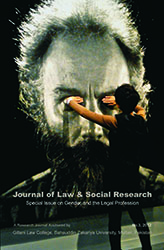Gender and the Legal Profession in Bangladesh: Achievements and Challenges
DOI:
https://doi.org/10.7146/nnjlsr.v0i3.111105Abstract
The history of women entering the legal profession in Bangladesh is quite recent. This is not surprising. Even in Western societies, with liberal cultural ideologies as regards gender-equality, women had to fight a lot to create a space for themselves in the legal profession. In the US case of Bradwell v. State of Illinois (1872), for example, the Supreme Court refused to allow a married woman into legal practice, arguing that 'the paramount destiny' of women is to fulfill the noble office of 'wife and mother'. Women in Bangladesh aspiring to enter the legal profession never faced such overt 'official' hurdles from the fellows of the same profession. Rather, a number of social, religious, professional, environmental and ideological factors have often stood, in various degrees, in their way. The Constitution of Bangladesh categorically prohibits discrimination based, among others, on sex. By contrast, it imposes a duty on the state to promote women's participation in every sphere of public life. Nevertheless, it is argued in this paper, Bangladeshi women in various walks of the legal profession continue to face implicit gender discrimination. There are factors that both dissuade women from choosing law as a profession and retard the career of those who are already in the profession. This paper brings into light and examines the factors that are arguably responsible for the hidden discrimination against women in the legal profession. For the purpose of this paper, the term 'legal profession' is used to mean legal practice in courts and elsewhere and the profession in the judiciary.
References
Abella, R. (1990) "Women in the Legal Profession", The Advocate, vol. 48, no. 3, pp. 507-515.
ABA (American Bar Association) (2006) A Current Glance at Women in the Law. Chicgo: Commission on Women in the Legal Profession, ABA.
Auchmuty, Rosemary (2011) "Whatever Happened to Miss Bebb? Bebb v The Law Society and women's legal history", Legal Studies, vol. 31, no. 2, pp. 199–230.
Brockman, J. (2001) Gender in the Legal Profession: Fitting or Breaking the Mould. Vancouver: UBC Press.
Buckley, Keith (2008) The Law Firms Working Group: Bibliography on Law Firms and Gender. Available at: <http://firms.law.indiana.edu/research/Gender.pdf>. Last visited 2 September 2012.
Chowdhury, Farah D. (2009) "Theorising Patriarchy: The Bangladesh Context", Asian J of Social Sciences, vol. 37, no. 4, pp. 599–622.
English, H. (2003) Gender on Trial: Sexual Stereotypes and Work/Life Balance in the Legal Workplace. New York: ALM Publishing.
Hoque, Ridwanul (2011) Judicial activism in Bangladesh: A golden mean approach. Newcastle upon Tyne: Cambridge Scholars.
Karim, Mahmud (2009) "The Lone Crusader: The Life and Works of Justice Nazmun Ara Sultana", Journal of Law and Development, vol. 1, no. 1, pp. 67–74.
Kay, H. M. (2004) Turning Points and Transition: Women’s Careers in the Legal
Profession – A Longitudinal Survey of Ontario Lawyers 1990-2002. Ontario: The Law Society of Upper Canada.
Khair, Sumaiya (1999) "Violence against Women: Ideology in Law and Society", vol. 3, no. 2, Bangladesh Journal of Law, pp 139–59.
Khatun, Sanjeeda "The Bunch of Memoires", The Special Eid Issue of the Daily Prothom Alo, Dhaka, August 2012, pp. 121–27.
Khondker, Habibul Haque (2004) "In Memorium: Salma Sobhan – A Human Being Extraordinaire', The Daily Star, Dhaka, 1 January, 2004.
Law Commission of India (2002). Legal Education & Professional Training and Proposals for Amendments to the Advocates Act, 1961 and the University Grants Commission Act, 1956. Report no. 184. New Delhi: LCI.
LawDev (Bangladesh) (2009) "Wholesale Politicization of Legal Profession: An Alarming Issue", Journal of Law and Development, vol. 1, no. 2, pp. 117–119.
Levinson, Justin D. and Danielle Young (2010) "Implicit Gender Bias in the Legal Profession: An Empirical Study", Duke Journal of Gender Law and Policy, vol. 18, no. 1, pp. 1–44.
Makhija, Sonal and Swagata Raha (2012) Gender Diversity in the Indian Legal Sector, New Delhi: Rainmaker.
Menon, Nivedita (2004) Recovering Subversion: Feminist Politics Beyond the Law. Urbana and Chicago: University of Illinois Press.
Monsoor, Taslima (2001), From Patriarchy to Gender Equity: Family Law and its Impact on Women in Bangladesh. Dhaka: UPL.
Mossman, Mary Jane (2006) The First Women Lawyers: A Comparative Study of Gender, Law and Legal Profession. Oxford: Hart Publishing.
O’Connor, Sandra Day (2003) The Majesty of the Law: Reflections of a Supreme Court Justice. New York: Random House.
Pearson, R. and A. Sachs (1980) "Barristers and Gentlemen: A Critical Look at Sexism in the Legal Profession", Modern Law Review, vol. 43, no. 4, pp. 400-414.
Sachs, Albie (1976) "The Myth of Judicial Neutrality: The Male Monopoly Cases". In Carlen, Pat (ed.) The Sociology of Law. Keele: University of Keele Press, pp. 105-33.
Sachs, Albie and J. H. Wilson (1978) Sexism and the Law: A Study of Male Beliefs and Judicial Bias. Oxford: Martin Robertson.
Schmitthener, Samuel (2005) "Development of the Legal Profession in India". In Deva, Indra (ed.) Sociology of Law. New Delhi: Oxford University Press, pp. 114-30.
Schultz, U. and G. Shaw (eds.) (2003) Women in the World’s Legal Professions. Oxford: Hart Publishing.
Sobhan, Salma (1978) Legal Status of Women in Bangladesh. Dhaka: BILIA.
___________ (2004) "Women, Religion and the Law". In Ahmed, Imtiaz (ed.) Women, Bangladesh and International Security: Methods, Discourses and Policies. Dhaka: UPL, at pp. 45-54.
Downloads
Published
How to Cite
Issue
Section
License
Counting from number 12 (2022), articles published in NNJLSR are licensed under Attribution 4.0 International (CC BY 4.0). Readers are allowed to copy and redistribute the articles in any medium or format, to adapt and revise the articles, and use the articles for commercial purposes, provided that the readers give appropriate credits.
No Creative Commons licenses are applied on articles in number 1 (2009)-11 (2021). All rights reserved by the authors. Readers are allowed to download, read, and link to the articles published in volume 1 (2009)-11 (2021), but they may not republish or redistribute these articles without permission of the authors.

